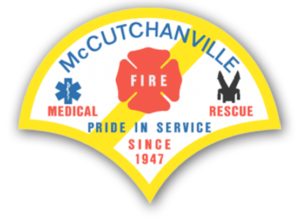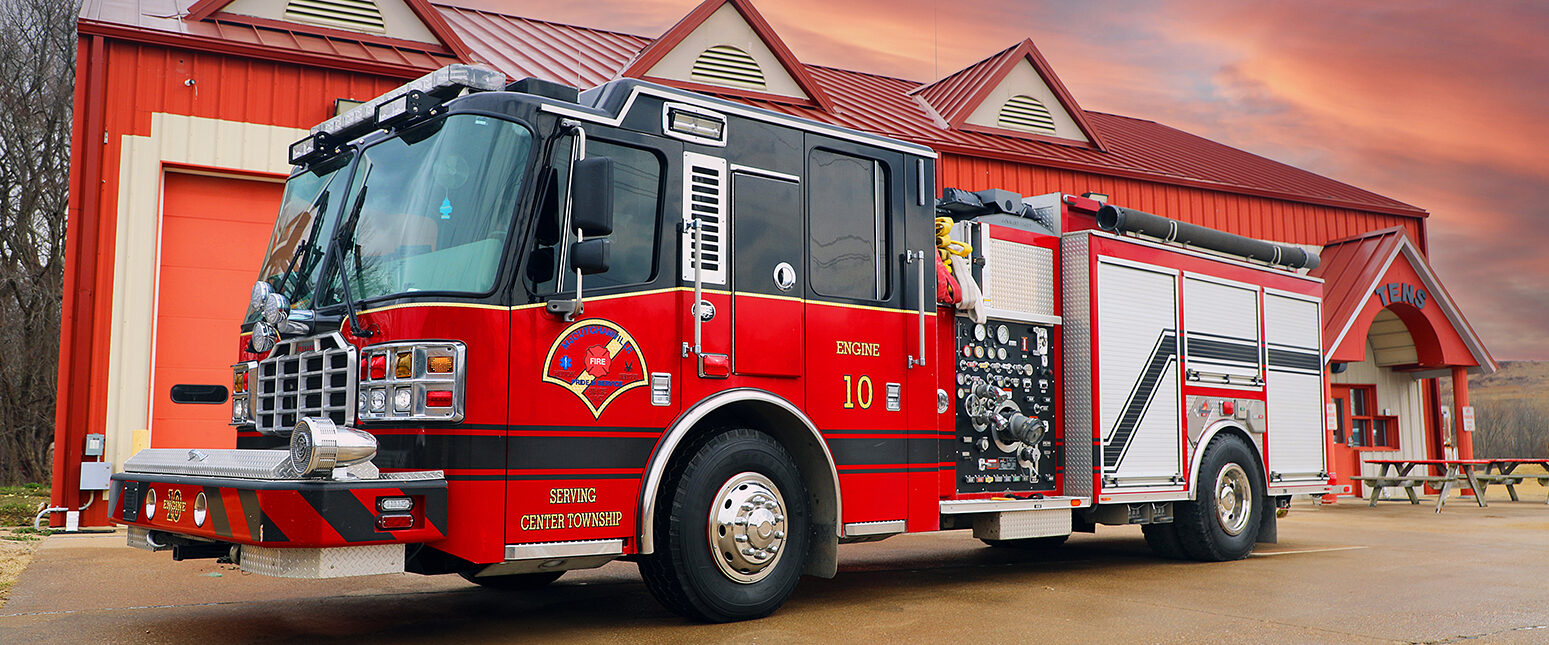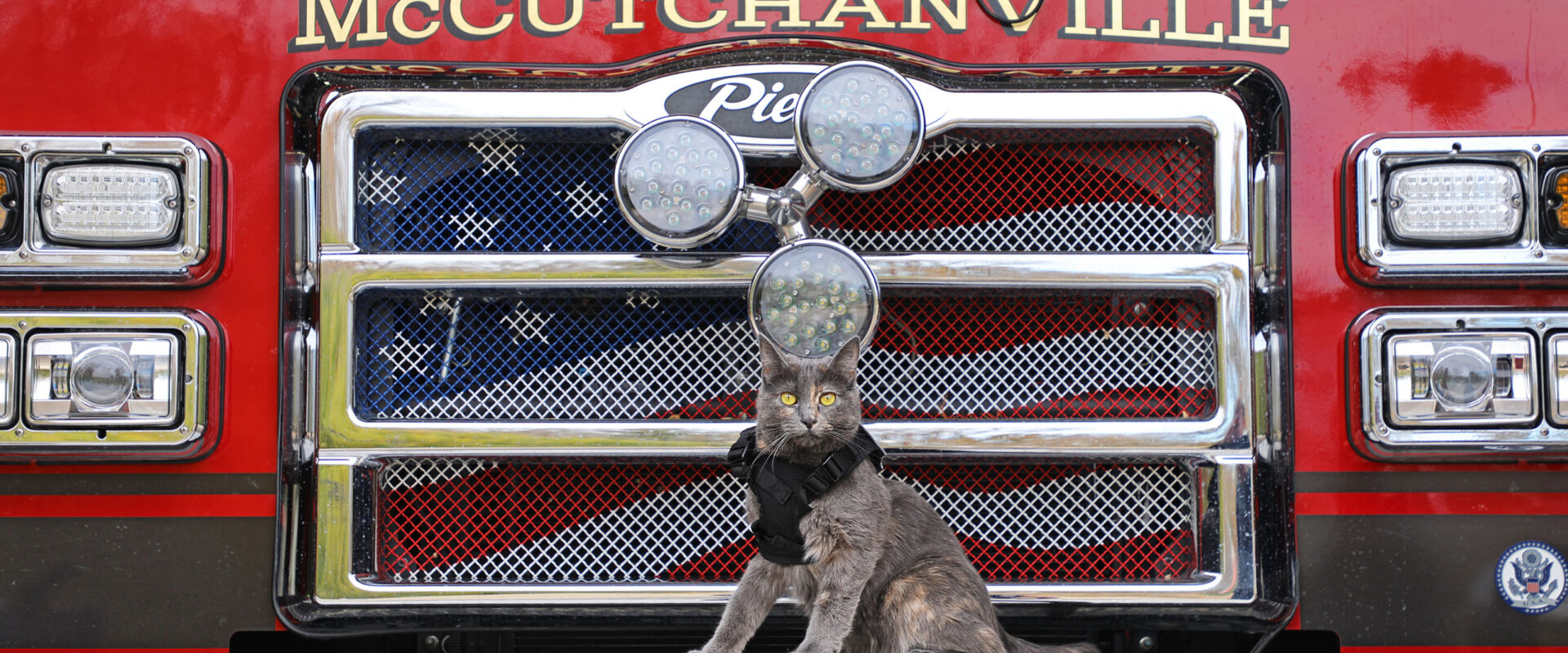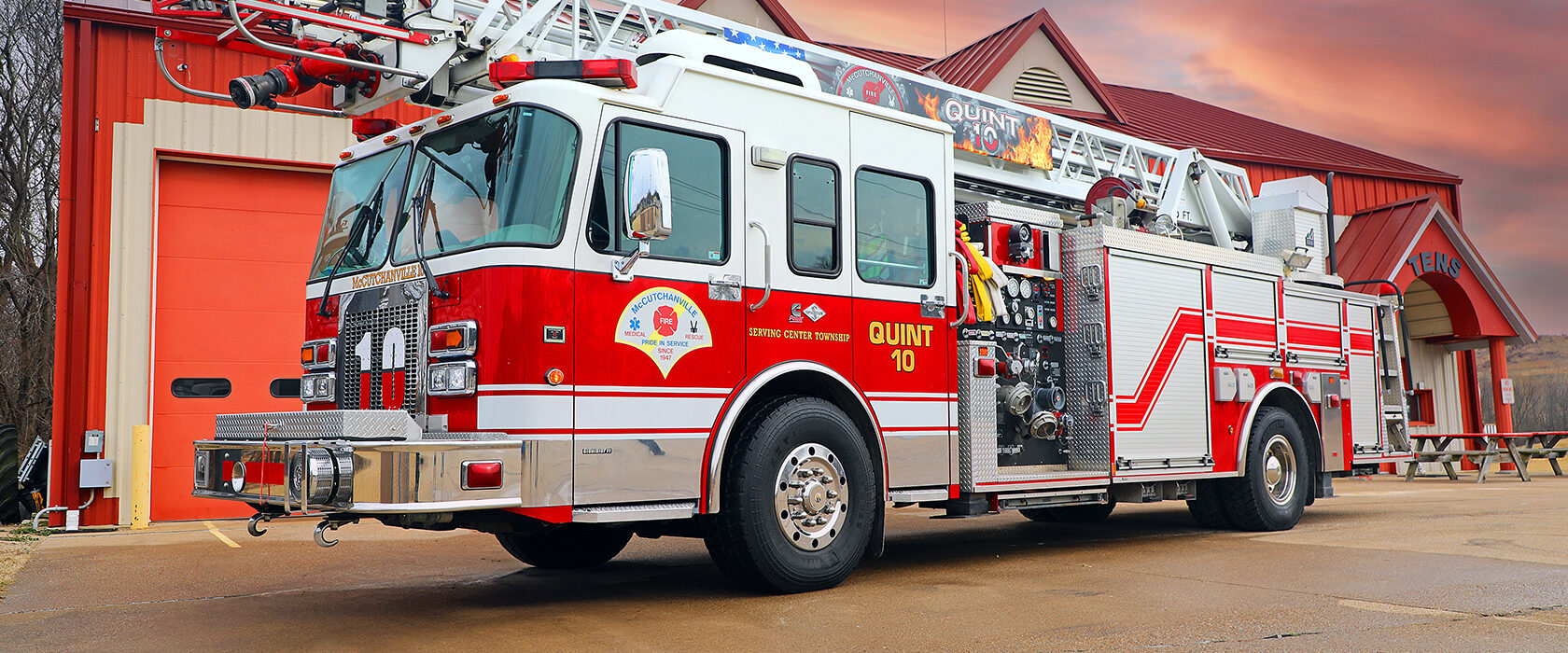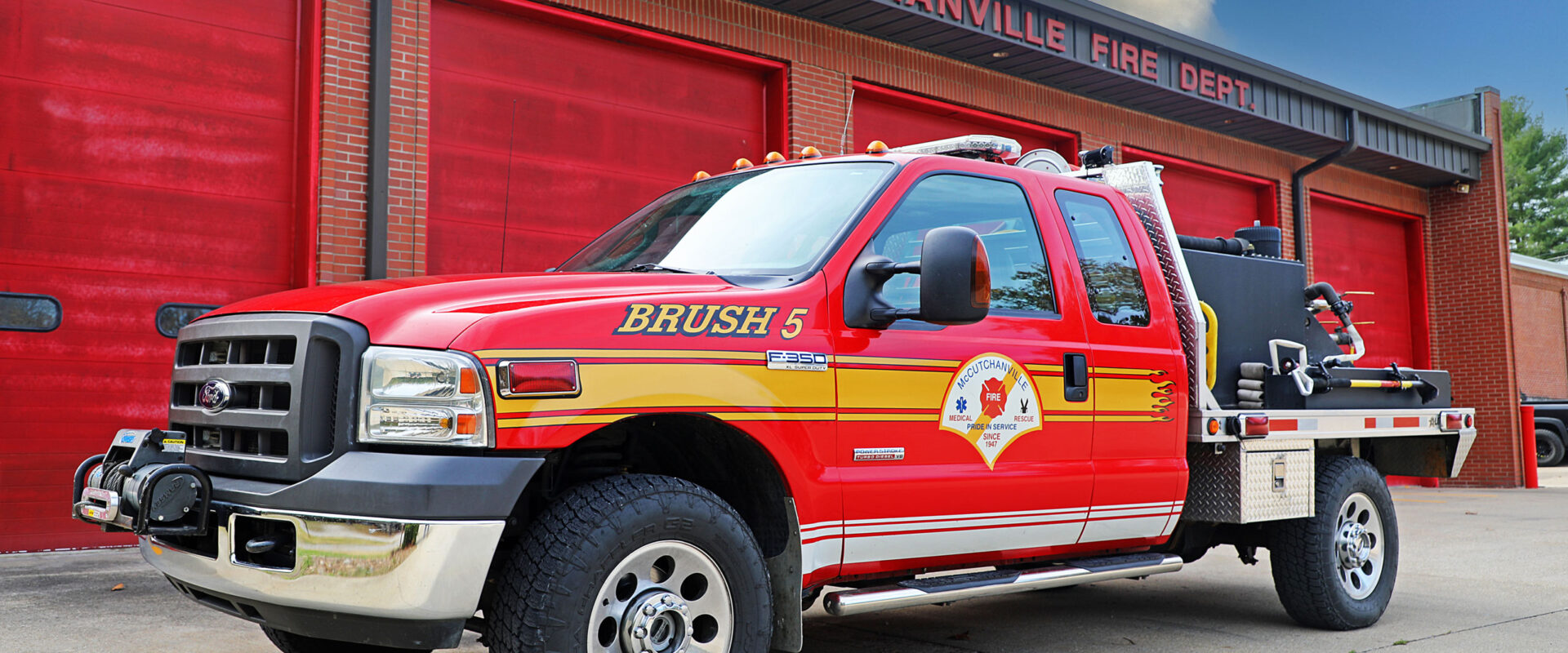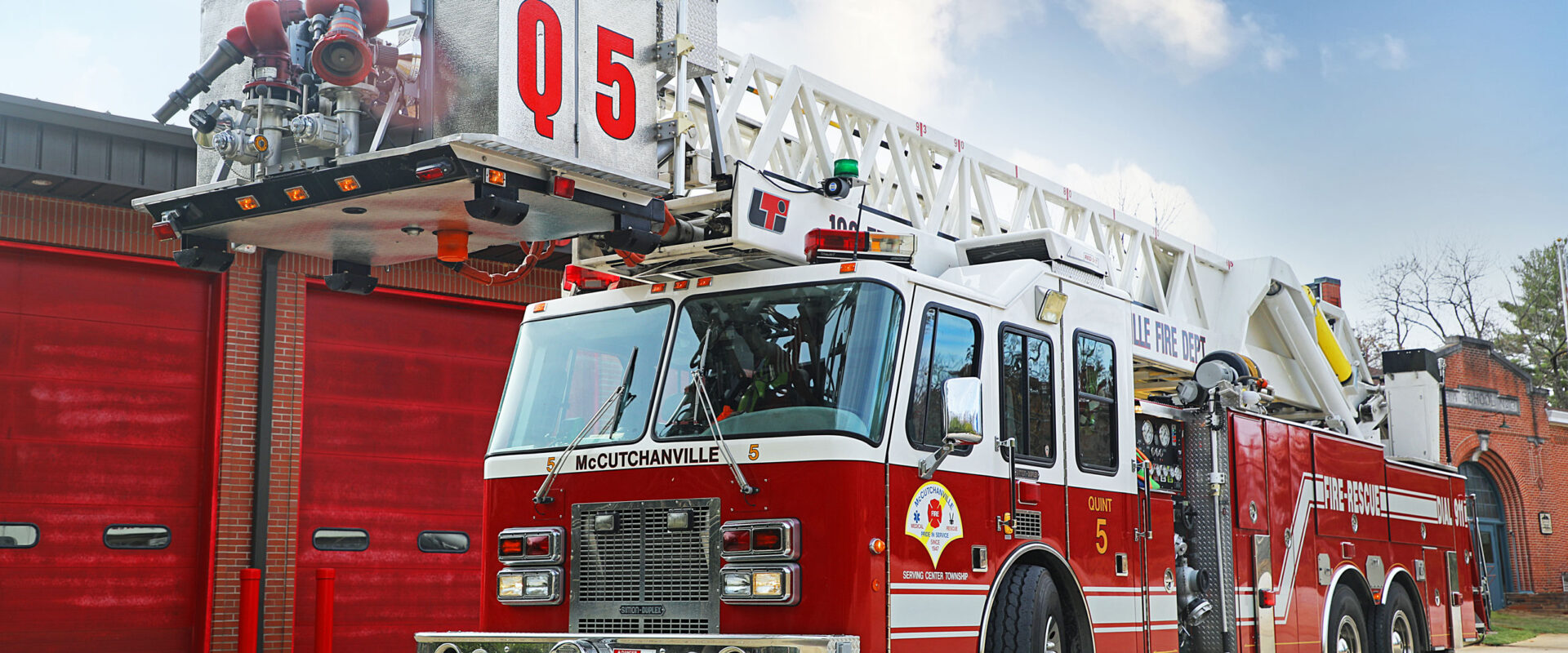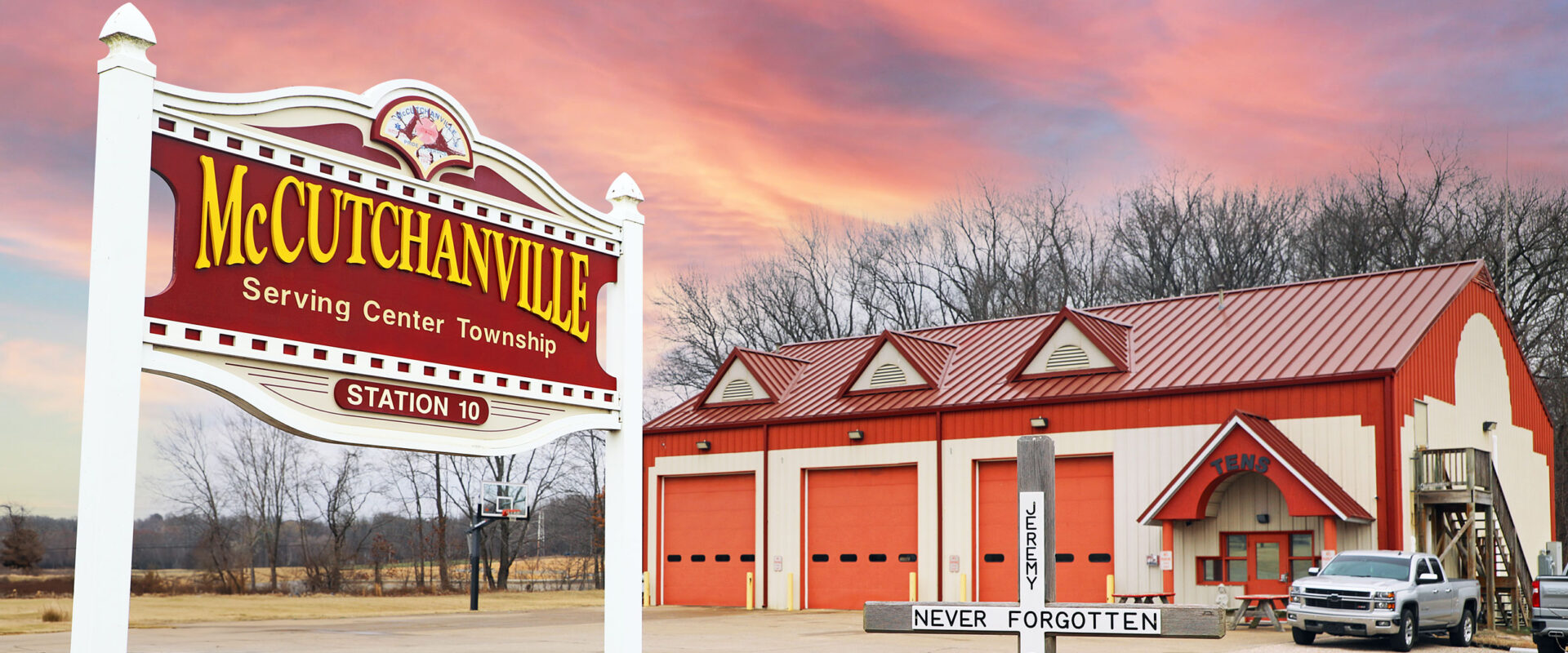For Emergencies Please Call 911
UE Plane Crash
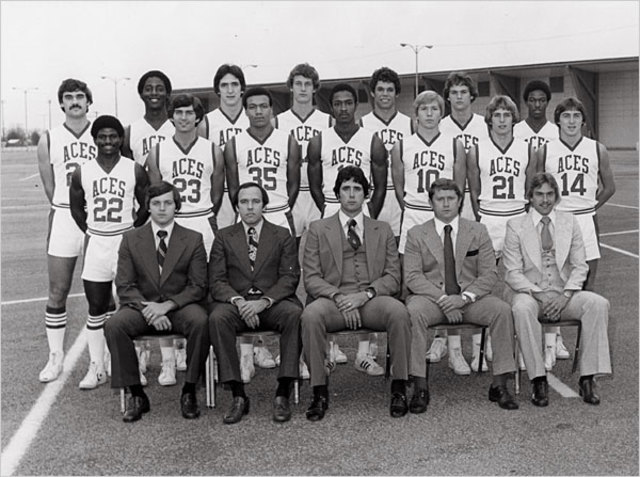
Though 30 years have passed, many Evansvillians remember what they were doing on the night of Dec. 13, 1977, when they heard about the plane crash that killed the hometown basketball team. Wallace Graves was enjoying a performance at Wheeler Concert Hall; Patrick Wathen was sitting down to supper; John Althoff was watching television. The quotidian quiet of that Tuesday night was shattered throughout the city as the details of the terrible accident trickled into living rooms, delivered by frantic phone calls and somber newscasts. It was clear by midnight that the Evansville community was in the midst of a great tragedy.
Among the dead were Coach Robert “Bobby” Watson; UE Athletic Business Manager Bob Hudson; UE Comptroller Charles Shike; Sports Information Director Gregory Knipping; popular radio announcer Marvin “Marv” Bates; and UE fans Maurice “Maury” King, the 33-year-old owner of Moutoux Furniture, and Charles Goad, 61, who owned Goad Equipment Co. The crash also claimed the lives of young men filled with promise and talent: seniors Kevin Kingston, John Ed Washington, and Marion Anthony “Tony” Winburn; juniors Stephen Miller and Bryan Taylor; sophomore Keith Moon; freshmen Warren Alston, Ray Comandella, Mike Duff, Kraig Heckendorn, Michael Joyner, Barney Lewis, Greg Smith, Mark Siegel; and the team’s three student managers, Jeff Bohnert, Mark “Tank” Kirkpatrick and Mark Kniese.

This band of young men was part of a pivotal moment in UE’s basketball program. Many of them had arrived in the shadow of the legendary Arad McCutchan, a beloved coach who’d guided the Purple Aces to 515 victories in his 31 years at UE, winning 40 of 50 postseason games, 14 Indiana Collegiate Conference titles, and five NCAA College Division championships. Nationally known and respected, McCutchan had coached two Olympic Trials teams and was twice named NCAA College Division Coach of the Year.
Beyond his coaching success was McCutchan’s engaging personality. Known as “Coach Mac,” the Columbia University- educated math professor brought a sense of fun to the game. He clad his players in boxing robes rather than warm-ups, outfitted them in T-shirt style jerseys, and instructed them to wear orange uniforms at away games. It worked. As Time magazine later recalled, McCutchan made the Purple Aces “the pride and passion” of Evansville. “Season tickets to the best seats,” Time noted, “were so hard to come by that die-hard fans fought over them in divorce settlements.”
In the heady days between 1959 and 1971, UE men’s basketball won its five national college championships, but by 1977 the program had lost some steam. Season ticket sales had dropped and just as the team was moving up into the NCAA’s prestigious Division I, McCutchan retired, at the age of 65.
University officials chose Bobby Watson, a charismatic, hard-charging coach who’d run up a string of victories as an assistant coach at Oral Roberts University, to follow in McCutchan’s wake. Watson understood almost immediately what UE basketball meant to the community, recruiting some hot-shooting freshmen, reviving the old Purple Ace riverboat gambler as the team mascot, and launching his own public relations campaign with Rotarians, Kiwanis Clubs, and community leaders to keep the rabid McCutchan fans on board and to win new ones. In the weeks after he was hired, 1,000 new season tickets were sold.
In spite of a bumpy start of three losses to one win, team spirits were high on the evening when Watson and his players boarded the chartered DC-3 airplane bound for Nashville and a game against Middle Tennessee State University the following day. They spent three hours waiting at the airport for the plane to arrive. The plane, owned by the Indianapolis-based National Jet Service, had been delayed by nasty weather.
Jim Stewart, president of National Jet Service, and Bill Hartford, the company’s general manager were already on board. Their charter service, just a year old, had flown 750,000 passenger miles without an accident and counted the state’s biggest universities among their clients.
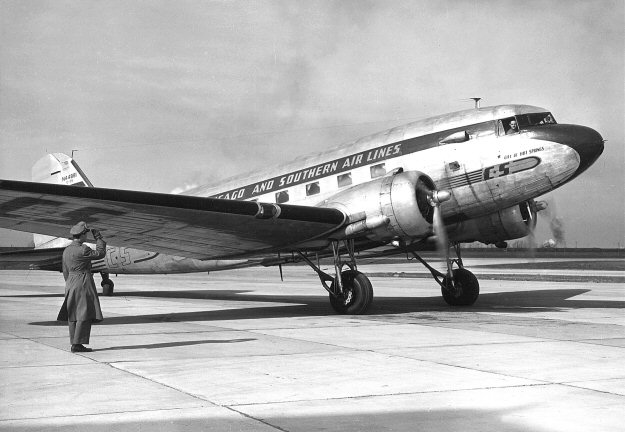
In the pilot’s seat for Air Indiana 216 was Ty Van Pham, hired by National Jet Service just two months earlier. He was among the thousands of refugees who fled Vietnam after the U.S. military’s pull-out ended the war and had been the personal pilot of South Vietnam’s prime minister. Pham had logged 9,100 hours of flight time when he joined the charter company. His co-pilot, Gaston Ruiz, a 35-year-old refugee from Cuba who moved to the United States in 1963, had logged more than 1,000 flight hours. Flight attendant Pamela Smith was only 24 and relatively new to the job with only 15 hours in the air.
Investigation reports would later show that after the aircraft landed and parked, both engines were shut down. The team’s baggage was loaded, and the passengers boarded. The plane’s engines started with no difficulties, and at 7:19 p.m., Air Indiana 216 was cleared into position on runway 18, where the pilots waited for a large plane to depart from an intersecting runway. Before clearing the Aces’ plane for take-off, a local controller warned Pham and Ruiz about wake turbulence, a kind of mini, horizontal tornado created in the air by a departing plane. Within seconds after liftoff, the pilots must have known something was wrong, because one of them instructed the tower, “Standby.” It was the last known transmission from the flight.
University of Evansville President Wallace Graves was attending a string quartet concert on campus with his wife Barbara when Thornton Patberg, vice president of student affairs, retrieved him from the audience and told him unconfirmed reports said the plane carrying the basketball team had crashed at the airport. Graves collected Barbara, who returned to their on-campus home while her husband met with Patberg and members of the athletic department before receiving an escort to police headquarters. “I was waiting for further orders,” Graves says, “and it seemed as though it never came to fruition.” Meanwhile, at the Graves home the telephone rang non-stop. Barbara fielded calls from frantic parents and worried friends, who heard unconfirmed reports that the UE plane had crashed at the airport. She had little information to offer. “We were under pains not to tell anybody exactly what was happening until the police verified everything,” Wallace Graves recalls.
Patrick Wathen, a 26-year-old reporter for The Evansville Courier, was working the police beat that night. He was home for dinner and had just sat down to eat when the phone rang. It was the newspaper’s city editor, calling to say a plane had crashed into Melody Hills, a subdivision southeast of the airport. Wathen had grown up on the corner of Dusseldorf and Hamilton Drives in the heart of Melody Hills, and his first thoughts were of his parents. “I tried to call,” he says, “and there was a dead line. Of course my mind’s flashing to the worst possibility.” He jumped in his car and raced from his home in Armstrong Township, northwest of Evansville, to his old neighborhood.
John Althoff, a 31-year-old police officer and crime scene technician, was at home on the evening of the tragedy, watching television. At about 7:30 p.m. a WFIE-TV 14 news anchor announced there had been a crash at the Evansville airport involving a large airplane. Though off-duty, Althoff rushed to the scene.
Ninety seconds after takeoff, Air Indiana 216 crashed into the muddy ground at the edge of airport property. The force of the impact sliced off the heels of co-pilot Ruiz’s shoes, which were on the control pedals of the aircraft. After the plane’s initial impact, the wings were ripped off, the propellers torn from the engines, and most of the passengers were ejected, many still strapped in their seats, into the cold night. The plane exploded and came to rest at the edge of a ravine, having traveled approximately 8,700 feet from takeoff on runway 18.
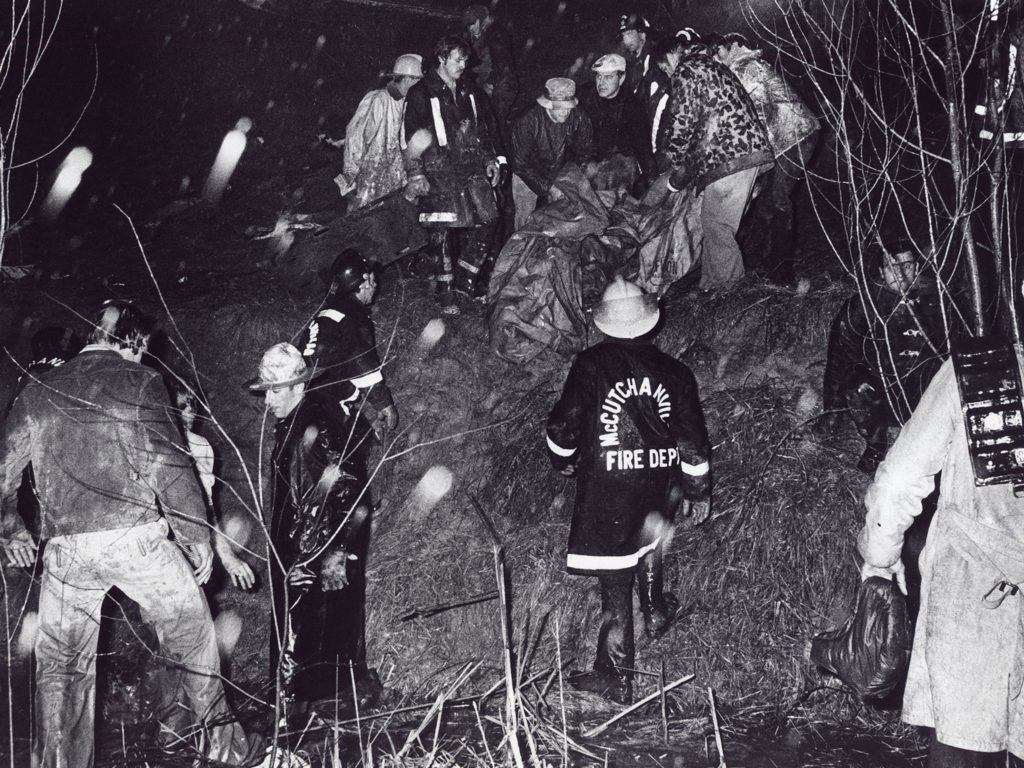
Witnesses later reported seeing the lights of the plane as it turned sharply toward Melody Hills. Some speculated the pilot may have realized there was a problem and was trying to return to the runway. They also reported an explosive noise like a shotgun blast. Investigators believed the engines lost some power, causing the pilots to increase throttle. The plane assumed an extreme nose-high, tail-low position, climbing into the clouds and disappearing for an instant before reappearing a moment later, headed toward the ground.
UE Athletic Director Jim Byers had originally planned to travel with the team but stayed behind to interview a candidate for a baseball coaching position. While he worked in his office on campus, the charter plane carrying the team clipped some trees near his home in Melody Hills. Air Indiana 216 struck branches 52 feet above the ground, tearing off the landing and strobe lights. Witnesses said the plane dipped wildly from side to side, and one resident reported a strange engine noise for nearly 15 seconds and then heard nothing. “It was as if the engines were turned off like a radio. Complete silence,” the resident told investigators. “I heard no crash or explosion.”
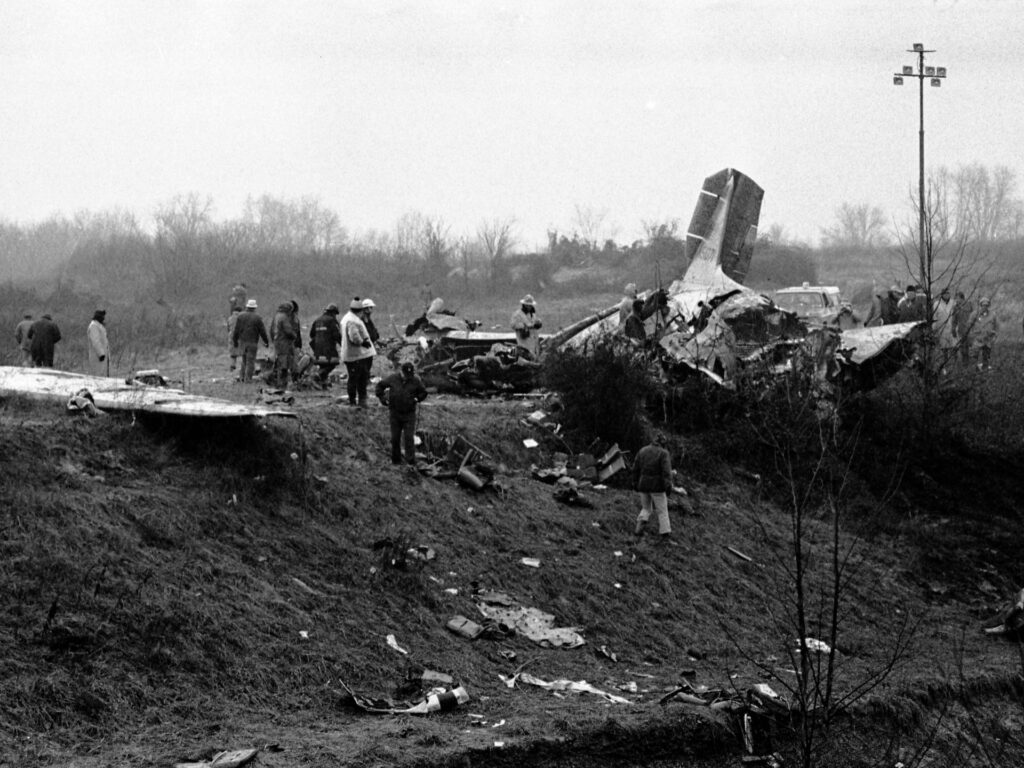
The first rescuers on the scene were Melody Hills residents who fought the rain and the mud, slogging down a steep, wooded embankment just northeast of where Ward Road dead ends. The railroad track below cuts through a ravine separating the neighborhood from airport property, and some of the victims had been flung into the pass. Some neighborhood residents administered first aid to victims, four of whom were still breathing, while others climbed the 20-foot bank on the other side of the ravine to reach the accident site itself. Investigators later estimated residents arrived more than 10 minutes after the plane crashed.
Hampered by weather, rescue workers scrambled to find the remote site. When John Althoff, the crime scene technician, responded to the accident, he parked his car in Whirlpool Corporation’s parking lot, just south of the airport, and rode with other rescuers to the crash site. Althoff’s partner on the police force, Terry Brooks, already was at the scene. Not only was the site remote, it was dark, and a thick fog shrouded any light offered by the thin sliver of moon. “It was so foggy when my partner got there, he heard the other responders coming, but he couldn’t see them,” Althoff recalls. “He had to fire a pistol in the air several times to get their attention.”
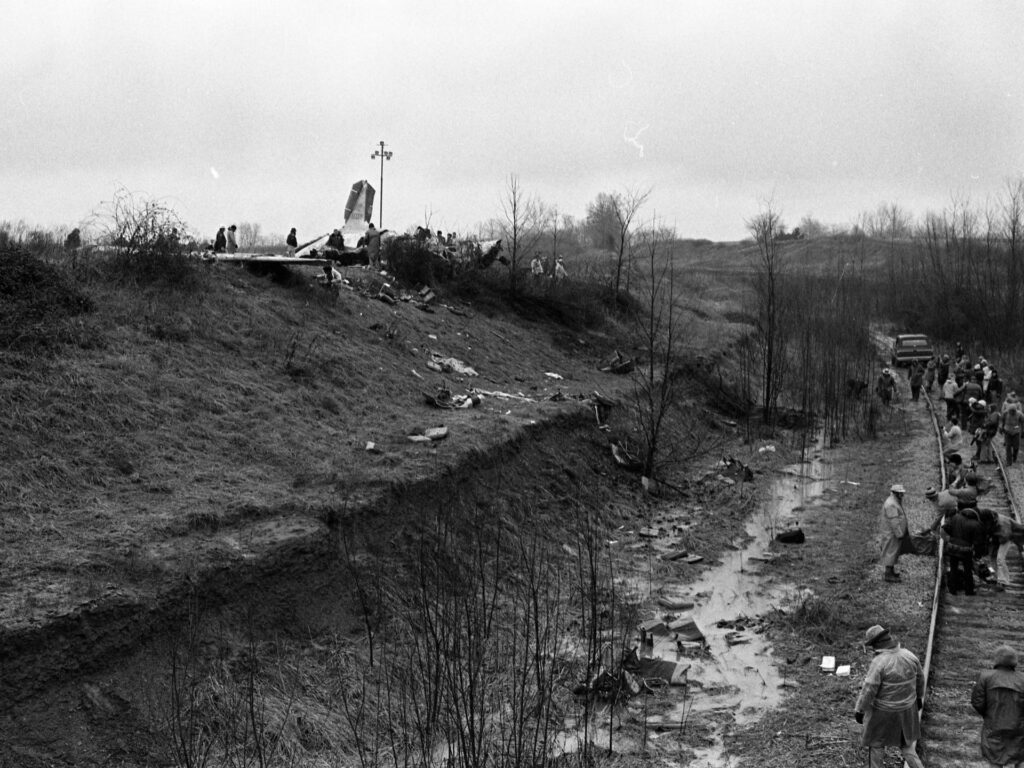
When Courier reporter Patrick Wathen arrived at Melody Hills, police already had blocked many of the roads into the neighborhood. He learned the accident involved a charter airplane, which he was told had businessmen on it, and he discovered the approximate location of the crash. Wathen, who had moved to the subdivision with his family when he was 7, had watched the Melody Hills neighborhood grow. He had spent his boyhood exploring the area, riding his bicycle down the steep slope into the ravine. He knew a back way in.
Wathen headed toward Oak Hill Road, east of the airport, and ran into Vanderburgh County Sheriff James DeGroote and his son David, a paramedic, who were also trying to find a way to the accident scene. Abandoning his car, Wathen joined the sheriff in his four-wheel-drive, and they drove to a nearby railroad crossing and turned onto the railroad track itself.
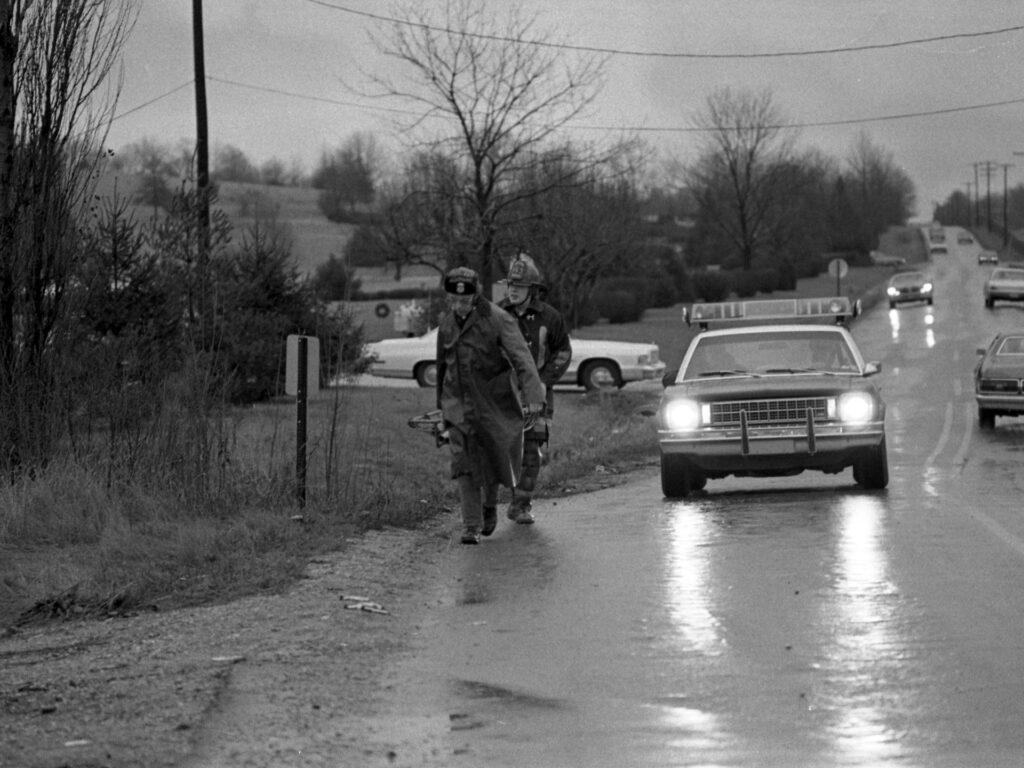
By all accounts, the weather and the remote location slowed the efforts of rescuers. Despite a fire from the wreckage, dense fog cloaked the flames, preventing airport personnel from determining the exact location of the plane. Airport officials had immediately dispatched their only two emergency vehicles, but because the plane crashed away from airport runways and paved roads, neither made it to the crash site. One crew ventured across the muddy, unpaved landscape and never found the wreckage. The other crew drove the airport’s unpaved perimeter road but slid off the wet road and down a five-foot embankment where their truck mired in the mud. The Evansville Fire Department sent nine vehicles, but none were able to reach the site because of the mud and the lack of roads. Firefighters abandoned their trucks and rushed in by foot.
The first fire department personnel to arrive on the scene were Evansville Fire Department rescue squad members Jim Wolf and Captain Matt Timmel. They had no idea what they were about to find. “We’d been to a couple of plane crashes out there over the years, and it was one passenger or two passenger (planes),” Timmel says. “This was kind of what we thought we were going to.” (Neither man could have known that 15 years later, on Feb. 6, 1992, they would again face a plane crash rescue, this time with the C-130 military turboprop that crashed into Evansville’s Drury Inn. Both firefighters were among the men receiving a Bronze Merit Award for that rescue.)
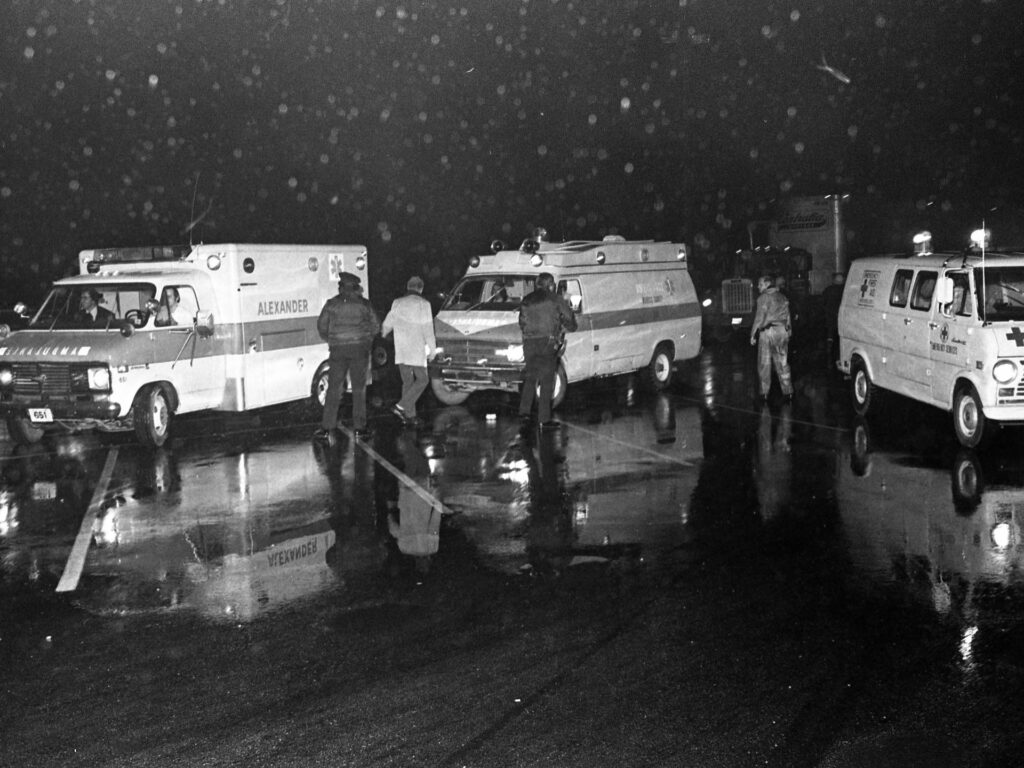
Hurrying across the sodden field, Wolf and Timmel approached the wreckage and saw a fire burning. The flames were blue, not orange, due to, Timmel says, the high alcohol content in the fuel. “(The fire) wasn’t ferocious,” he adds. “It was sitting there like a little bonfire.” With the fire lighting the scene, Wolf and Timmel were stunned to see the huge tail-end of a DC-3 sticking up in the air.
When Wathen arrived, bumping along the rough track with the sheriff, he saw a small fire burning on the northside ridge. Bodies of crash victims were lined up along the railroad track. The journalist did not yet realize most of the bodies belonged to the city’s beloved Aces, their coach, support staff, and two fans. Wathen climbed through the brush and mire to the top of a ridge and looked down. He saw an Aces duffel bag, and then he knew.
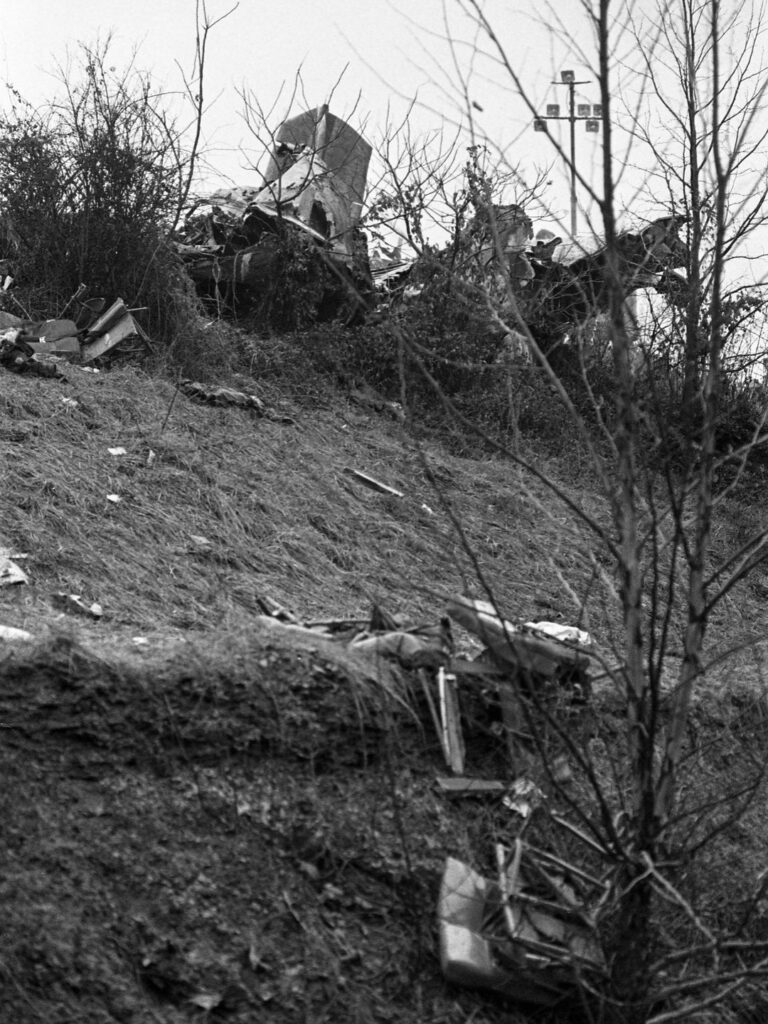
Althoff had a similar realization. Walking the scene with another rescue worker, he came across an open suitcase. Shining his flashlight on the bag’s contents, he saw some of the team’s equipment. “My God,” Althoff said. “It’s the Aces.”
Debris from the wreckage littered the accident site: a burning seat cushion filled with gasoline came to rest in a puddle; the banner Marv Bates hung on the front of his announcer’s booth at games lay in the mud; a lone athletic shoe, missing its owner, sat at the bottom of the ravine.
Rescue workers from the airport authority, the state police, sheriff’s department, city police, and two fire departments responded to the scene. Nearby McCutch-anville Volunteer Fire Department sent a fire truck and crew, who traveled south along the railroad track and arrived nearly 20 minutes after the crash. It was the only fire truck that reached the site. Within an hour of the crash, the scene was so crowded, that as Timmel recalls, “it was difficult to move.” Someone, it is not clear who, in those bleak, chaotic hours after the crash decided the bodies should be loaded onto a boxcar and transported out of the ravine to a makeshift morgue at the C.K. Newsome Community Center, which was on the train line Downtown.
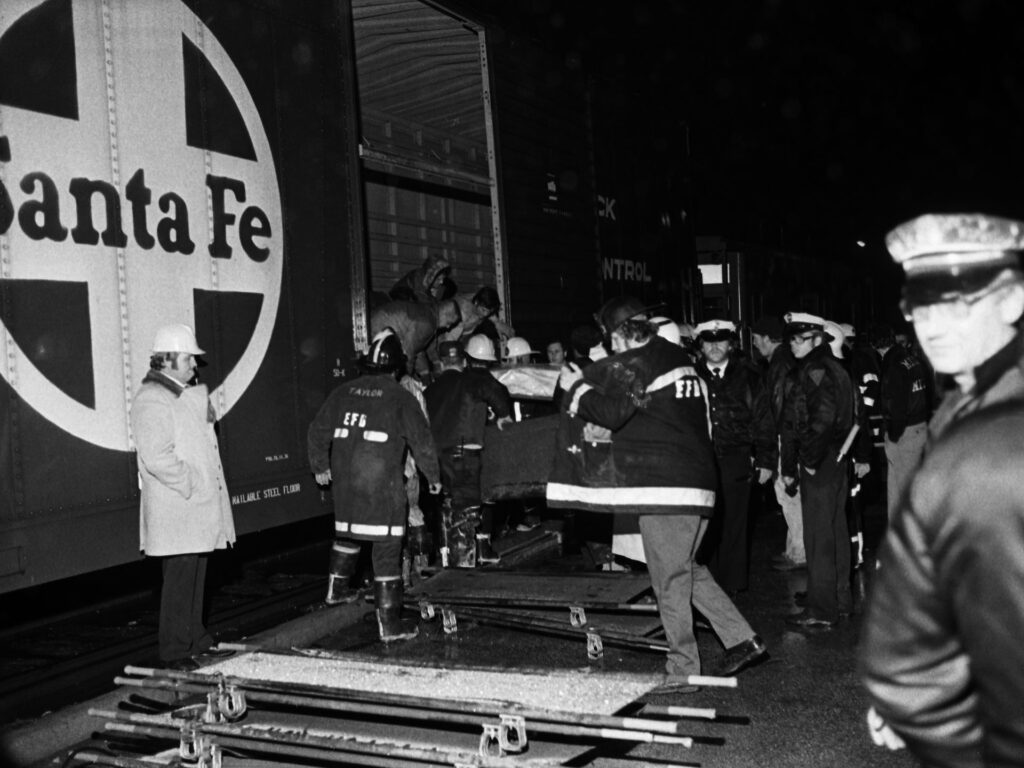
It was a scene Wathen will never forget. Sometime before midnight, an engine, one solitary rail car, and a caboose solemnly backed down the railroad track. A red flare glowed in the fog. The conductor sounded a warning whistle that reverberated like a dirge on the unforgiving walls of the ravine. “One thing I’ll always remember,” Wathen says, “is that shrill train whistle and red glow of the flare piercing through the stillness of that foggy night.”
Timmel and rescue squad member Jim Wolf were among the emergency workers who rode the train away from the accident site to the community center. The conductor pulled to the back of the building, where Timmel and Wolf helped unload the bodies and carry them into the gymnasium.
All but three bodies were recovered when the rain and the darkness forced authorities to postpone the search until the sun rose. The bodies of co-pilot Gaston Ruiz, pilot Ty Van Pham, and National Jet Service owner Jim Stewart were recovered the day after the crash. They had been seated in the cockpit, which was buried under the wreckage. Of the four passengers who initially survived the crash, three died at the scene. Only one, Greg Smith, a freshman walk-on, was rushed to Deaconess Hospital where he died shortly after midnight, five hours after the accident.
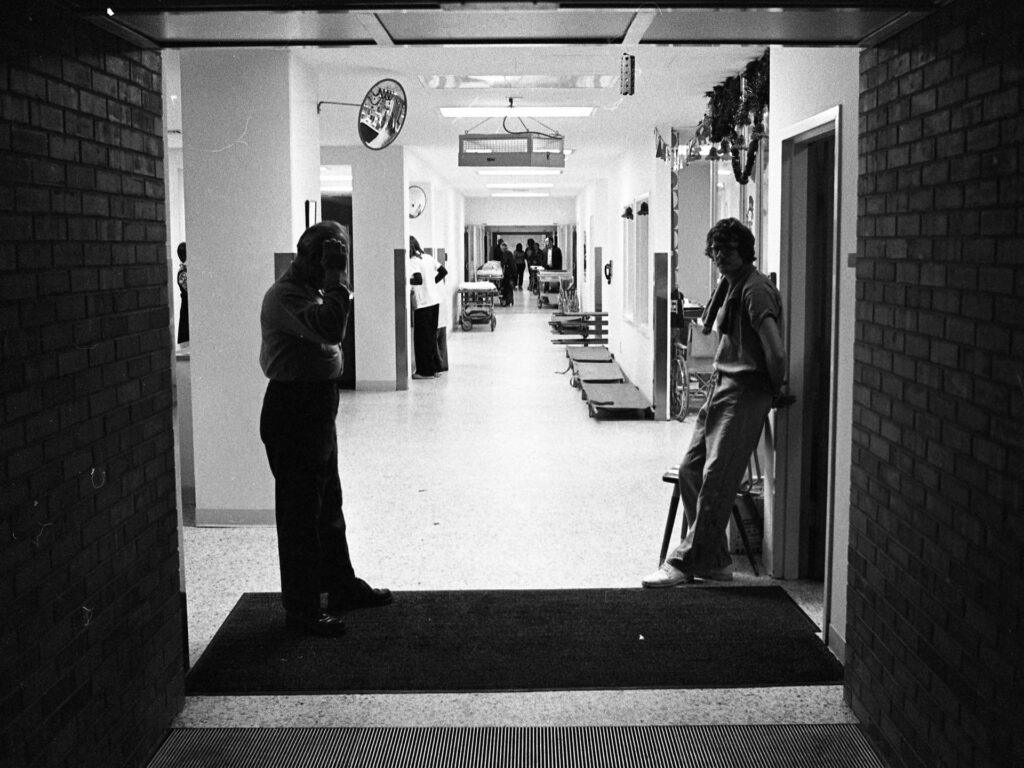
On the night of the crash, assistant coaches Ernon Simpson, Stafford Stephenson, and Mark Sandy were out of town on recruiting missions. Simpson, who had coached high school basketball in Kentucky before coming to UE, was sitting with his wife in an Owensboro high school gymnasium scouting prospective players when the plane went down. During the game, he was summoned to an office where he watched early news broadcasts of unconfirmed reports that the UE plane had crashed. Simpson, not knowing Air Indiana 216 had been delayed, immediately headed for Evansville, hoping the reports were wrong.
That evening, Jeff Kniese, then a 16-year-old sophomore at Harrison High School, was celebrating his independence, hitting the road for the first time with his newly acquired driver’s license. He was in the stands at a Harrison basketball game when rumors of a plane crash at the airport quickly moved through the crowd. Kniese wasn’t worried, believing the UE plane – the one carrying his brother Mark, the team’s student athletic trainer – had left hours before. Hanging out at the Lincoln Avenue McDonald’s after the game, another student informed Kniese the plane carrying the Aces had crashed. Kniese sped home to an empty house, still uncertain if the news reports were true. When the phone “began ringing off the wall” with calls from concerned family members and friends, “I had no idea what to do,” Kniese says.
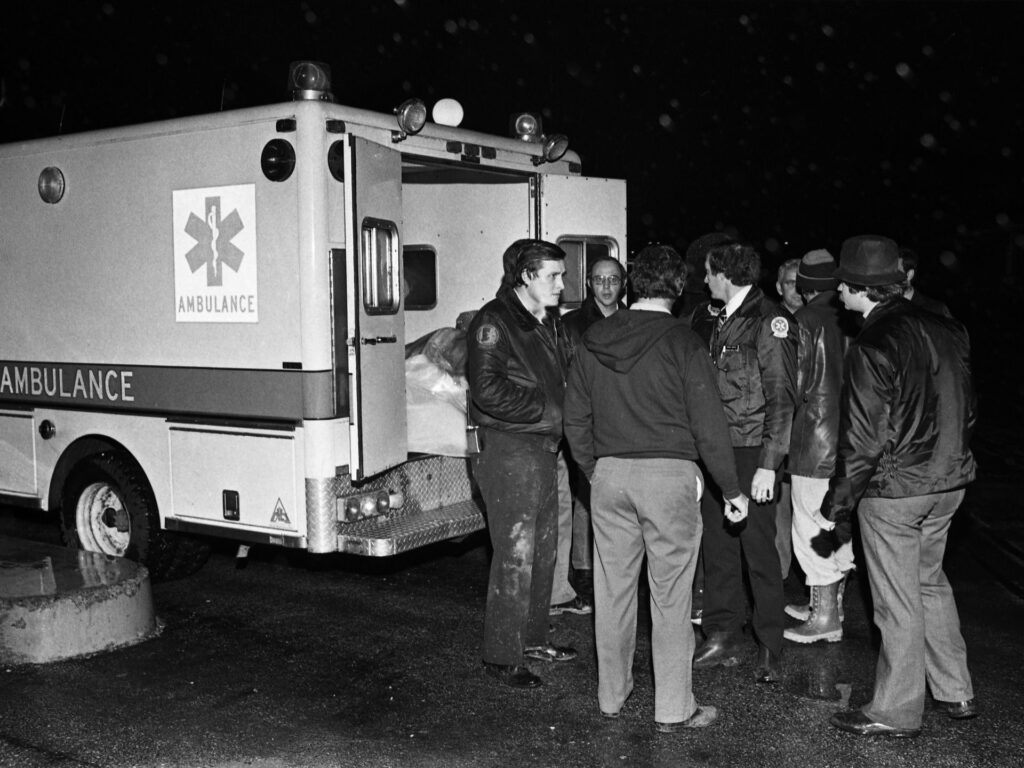
At about 7:30 p.m. – 10 minutes after her husband’s plane had crashed – Kathy Vonderahe, Maury King’s wife (who has since remarried), was sitting down at home with her two young children to watch television. King, a UE fan and furniture store owner, had grown close to the Aces. His friend, broadcaster Marv Bates, had offered King the opportunity to do the color commentary for games, and the UE game against Middle Tennessee State would have been his debut performance in a season game. When Kathy saw the earliest news reports that a plane had crashed at the Evansville airport, she wasn’t terribly concerned, knowing her husband’s plane was scheduled to leave much earlier. “When I heard about it, I thought he had been gone for hours,’’ she recalls. Some early reports even said an incoming plane had crashed, adding to the confusion, but as the evening wore on, news reports became more worrisome.
Sometime before midnight, Graves left the police station and went to the community center to comfort family members. State and local police, firefighters, rescue workers, and reporters filled the center. Outside, crowds of grief-stricken students and city residents gathered. The university enlisted the help of grief counselors and clergy from several churches and ushered victims’ loved ones into private areas of the center. Arad McCutchan, still living in Evansville after his retirement, assisted officials with identifying the bodies.
Althoff and his colleagues in the crime scene unit examined the victims, fingerprinting and photographing as they moved from body to body. They, along with a paramedic and a pathologist from the coroner’s staff, determined the cause of death for all the victims: blunt force trauma. The coroner’s office elected not to autopsy the bodies – there were just too many and the fatal injuries they’d suffered were visible. The three crew members were the exception; the government required their autopsies as part of the crash investigation.
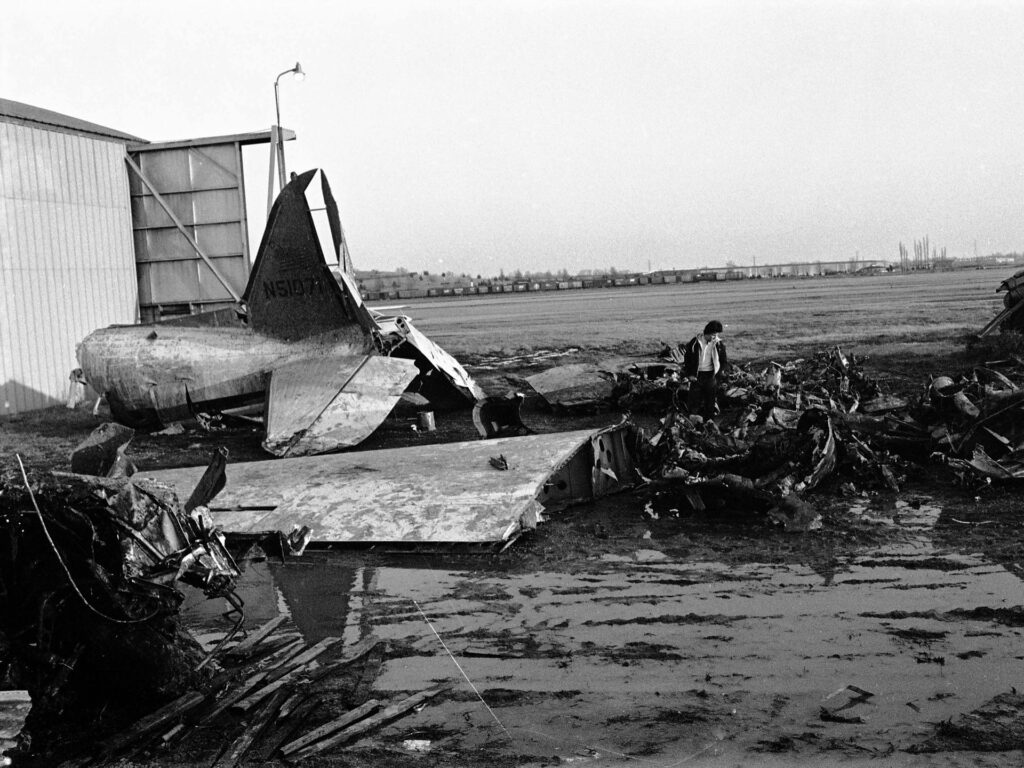
Jeff Kniese remembers his father, Norman, headed to the community center to see if his middle son was among the victims. “We had heard there was still one person alive at one of the hospitals,” Jeff recalls. “So there was a ray of hope for my family it would be my brother Mark.” It was not to be.
Three friends of Kathy Vonderahe, all policemen, identified her husband’s body in the makeshift morgue. They told her there was no need for her to go, but she was adamant. She needed to be sure that Maury had been on the plane. After tucking her two young children into bed, Vonderahe ventured into that miserable night to view the body of her high school sweetheart.
It was after midnight when Graves returned to campus. Police still had not given him permission to release any information, but he and university officials finally called the parents of the team members to tell them what they knew. “Everybody knew that there had been a crash and who was aboard,” Graves recalls. “We couldn’t see any point in not doing so.”
Enormous grief descended over the campus and the city in the days after the accident. Graves and his colleagues attended funerals across the Midwest and beyond. “Imagine going to that many funerals, some of them in little rural places, some in larger cities, big churches, little churches, no churches,” Graves says. “Barbara and I got to almost all of them.” In the days before Christmas, families were burying sons, brothers, husbands, and fathers, and university officials felt compelled to do what they could. UE paid for the funerals and offered the surviving siblings, widows, and children of the victims a scholarship to the university, redeemable throughout their lifetimes. (Some, like Kathy Vonderahe, accepted the offer, while others, like Jeff Kniese, did not.)
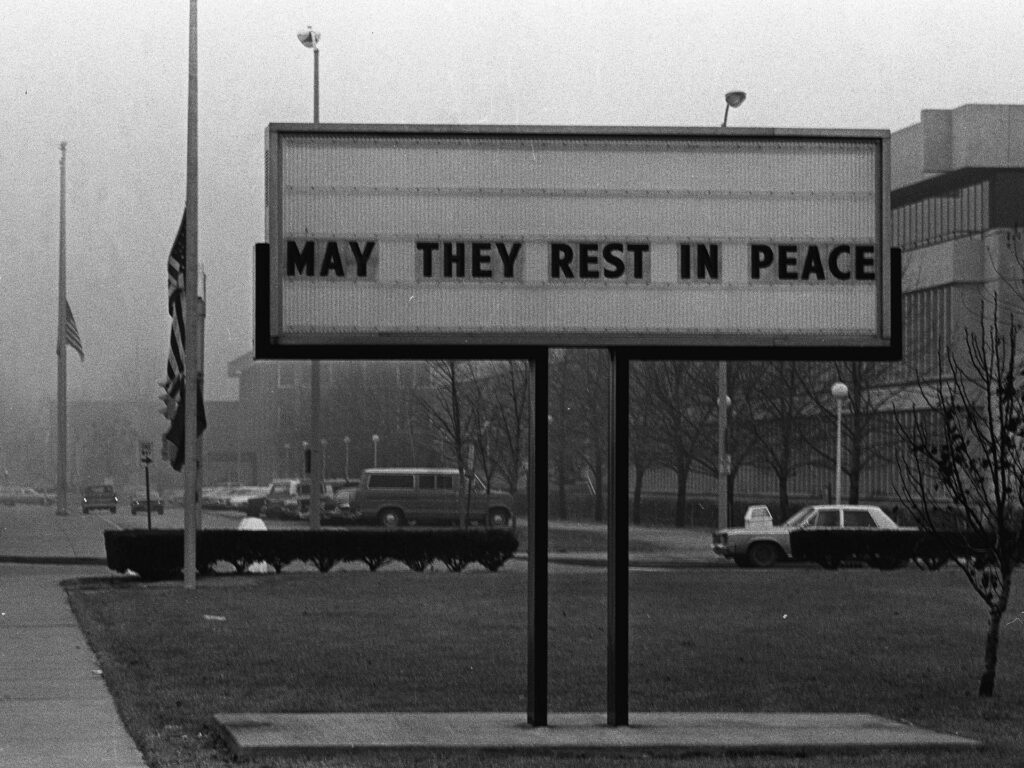
There was, though, another terrible turn of fate. Cut from the team because of an ankle injury, UE freshman David Furr, the Aces’ statistician, was not on the plane. Two weeks after the crash he and his 16-year-old brother were driving home from a holiday basketball tournament and were killed in a car accident in Newton, Ill.
Months after the crash, investigators with the National Transportation Safety Board issued their report, ultimately blaming the accident on human error, deciding that neither the weather nor wake turbulence directly caused the crash. They concluded the probable cause leading to the deaths of all 29 aboard Air Indiana 216 was two-fold: Too much baggage was loaded in the back of the plane, shifting the center of gravity to the rear, compounded by the co-pilot’s failure to remove control locks on the rudder and the right aileron, a control hinge on the wing. Standard safety procedure called for the co-pilot to put the control locks in place when the engines were turned off after landing and then remove them before take-off. Whether it was because of the weather or because the flight was already so late, he failed to remove two of the control locks. The NTSB investigators said an experienced pilot like Pham probably would have been able to keep the plane in the air if only one of the problems existed, but the locked controls and a back-heavy plane proved a deadly combination.
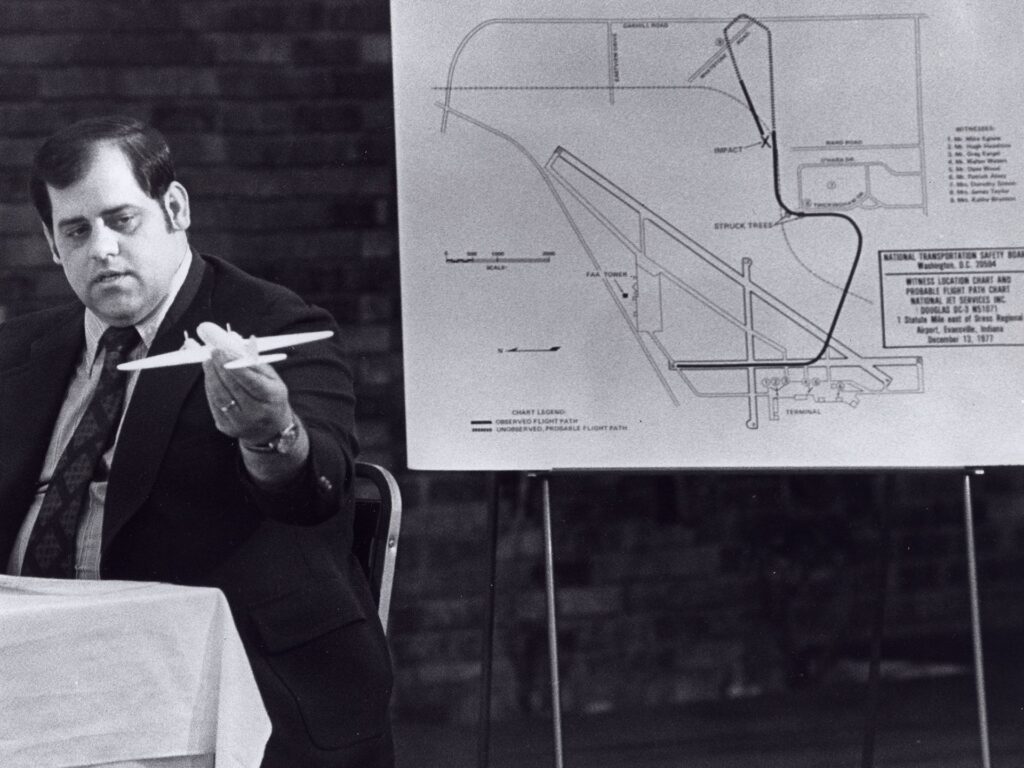
The NTSB report concluded the accident was “not survivable.” Still, investigators noted their concern about the time lapse between when the plane crashed and when emergency workers were able to reach the site. Among the recommendations to the Federal Aviation Administration was to require airports have rescue vehicles with off-road capabilities. The FAA rejected the recommendation, saying a requirement of access roads, already in place, was sufficient. In the wake of the crash, Evansville airport officials paved the perimeter road that provides access to remote areas on the property and purchased a fire truck designed to reach off-road locations. Additional access roads have been added to the property in the years since.
Five days after the crash, speaking to a Roberts Stadium crowd of 4,000 mourners that included Indiana Gov. Otis Bowen, U.S. Sen. Birch Bayh, and Evansville Mayor Russell Lloyd Sr., Graves offered a message of hope. “Out of the agony of this hour, we will rise. Out of the ashes of a desiccated dream, we shall build a new basketball team, stronger, more valiant than ever before,” he said. Initially, the university considered continuing the season with a new team culled from other student athletes but decided against it. “We thought that’d be more of a travesty than not,” Graves recalls.
The university canceled the rest of the season. To help the university rebuild the program, the NCAA waived a rule requiring transfer athletes to sit out their first year at a new school. Junior college coach Dick Walters from the College of DuPage in suburban Chicago was hired as the Aces new head coach. When UE had replaced McCutchan with Bobby Watson a year earlier, they had not seriously considered anyone from the junior-college ranks, but the situation had changed drastically. “I knew we had a very difficult task ahead of us,” Graves says. “We needed somebody who was hungry to be successful.”
Walters’ first season was difficult with his team losing their first five games. But they slowly recovered, and Walters would go on to coach the Aces to winning records in four of his seven years at UE. In 1982, the Aces won the Midwest Collegiate Conference title and earned their first NCAA Division I tournament bid.

The crash was reported by the national media, including Walter Cronkite on the CBS Nightly News, and people across the nation expressed sympathy. The city, the families of the dead, and the university received an outpouring of support. The day after the crash Graves received a call from the president of Marshall University, which had lost 36 members of its football team in a plane crash seven years earlier, a tragedy dramatized in the 2006 movie “We Are Marshall.” The school’s president expressed his condolences and offered to send members of his staff who had dealt with their tragedy. “We didn’t ask them to come,” Graves says, “but we appreciated it.” In late December, Southern Illinois University, a long-time Aces rival, hosted UE’s long-standing holiday tournament at Roberts Stadium. More than 10,000 people attended, and participating schools declined any proceeds beyond the costs of the event. In February 1978, some members of the 1976 Super Bowl champion Pittsburgh Steelers played a charity exhibition basketball game at Roberts Stadium against University of Evansville alumni players, coached by McCutchan
The tragedy that claimed the hometown team bound people together. “Normally, when you lose someone and you’re out in public, they’re all going about their lives, and you think, ‘Don’t you know what happened to me?’” Kathy Vonderahe says. “In this case, no matter where you were, everyone wanted to share their story.”
According to newspaper reports, some families of the victims reached out-of-court settlements with National Jet Service. Because an Indiana law restricted the amount that can be recovered from the death of a young person without dependents, families of team players and managers from Indiana did not receive as large a settlement as families of victims from other states. Compensation ranged from about $65,000 to $100,000.
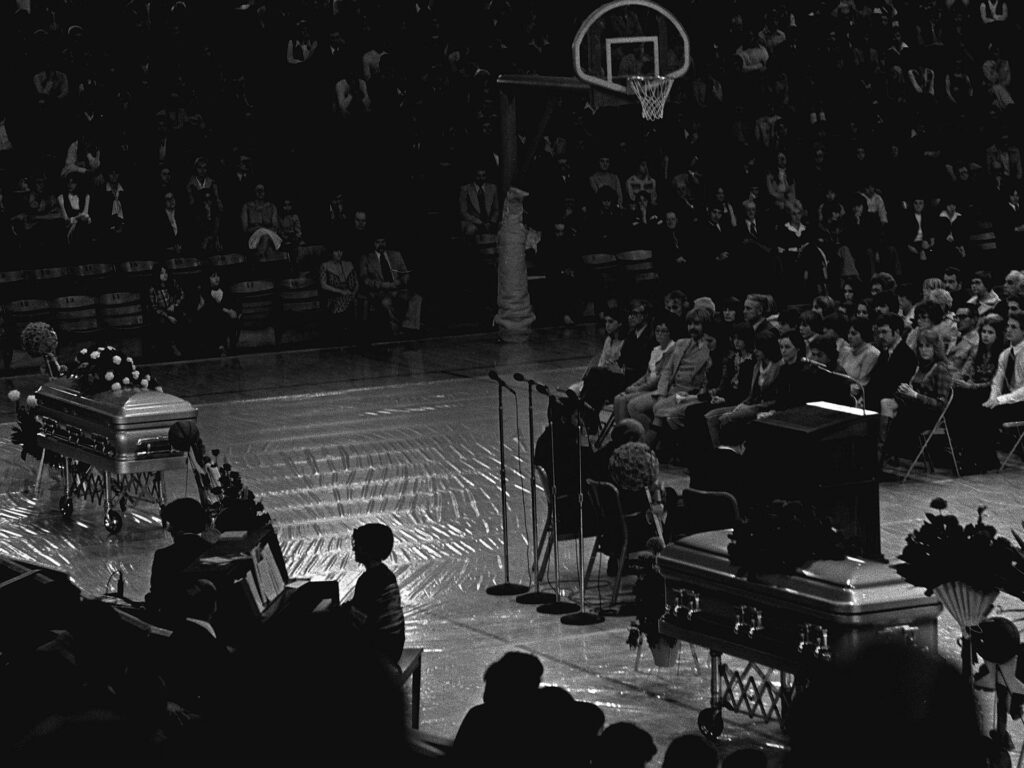
Approximately $350,000 was donated to the university in honor of the dead. It was used to fund scholarships for the victims’ families, rebuild the basketball program, and construct a memorial as a tribute to the victims. At the far end of what is known as Memorial Plaza, two stone walls, inscribed with the names of those lost in the tragedy, create a doorway to an inconspicuous haven. In the center of a brick-hewn basin, a simple fountain spews water in a shimmering orb, the “Weeping Basketball.”
The victims of the crash are not forgotten. Evidence of this emerges in small but meaningful ways. Nearly 20 years after the fatal crash, Jeff Kniese’s family received a call from a woman who’d been a counselor with Mark Kniese at the YMCA’s Camp Carson when the two were in college. She asked the Knieses for their blessing to create a scholarship in his name.
